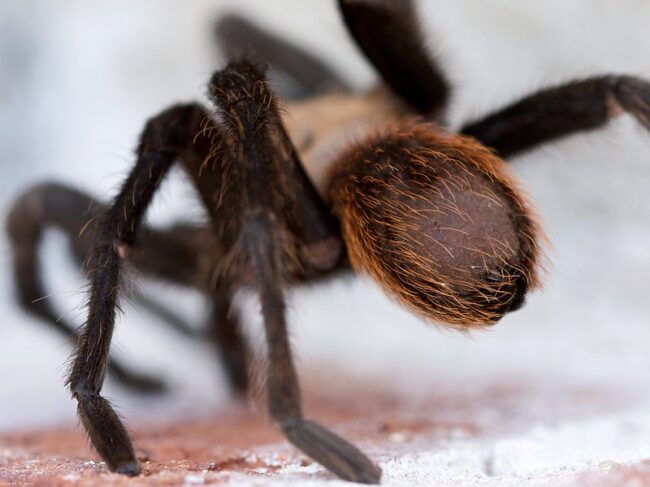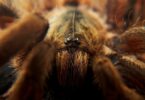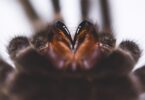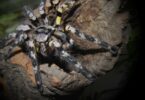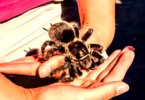Dealing with a tarantula’s itchy defenses can be both puzzling and irritating. These creatures use special hairs, known as urticating hairs, to protect themselves from predators. Our article dives into the world of tarantula urticating hairs, helping you understand their purpose and how to manage any unwanted effects.
Keep reading for a surprising journey through nature’s tiny barbs!
Understanding Urticating Hair
Now that we’ve touched on tarantulas, let’s dive into what urticating hair is. These special hairs are like tiny needles. Tarantulas have them to protect themselves from enemies. The hairs can irritate skin and eyes if they touch you.
When tarantulas feel scared or threatened, they may release these hairs to bother their attacker and get away.
Urticating hairs are not all the same; there are different types. Some tarantulas use Type II urticating hairs for defense. They either kick these off their bodies or press them into other animals when they touch each other.
These hairs help mark their home area too and keep their egg sacs safe from harm.
Urticating Hair in Tarantulas
The unique defense arsenal of tarantulas includes urticating hairs — microscopic barbed bristles that can cause irritation and deter predators. Let’s delve deeper into how these fascinating creatures develop this feature, the various types they possess, and what makes them so effective for survival in their natural habitats.
Development
Tarantulas grow urticating hairs as they get older and bigger. With each molt, which is when a tarantula sheds its old skin to grow, these special hairs develop. About 90% of New World tarantulas have them once they are adults.
Each time the tarantula molts, it can get more urticating hairs. These hairs are part of how they protect themselves.
Types
Tarantulas have different kinds of urticating hairs on their bodies. These hairs are special because they help the spider stay safe from danger. Some types, like III and IV, are really good at keeping mammal enemies away because they are extra bothersome if they get into skin or eyes.
The types of urticating hairs can tell us which tarantula species we are looking at. For example, a tarantula might have Type I, II, III, IV, V, or VI hairs. Each type has its own way of helping the tarantula protect itself.
This is one reason why these amazing spiders can live in many places with different dangers around them.
Types Specific to Species
Different kinds of tarantulas have their own special types of urticating hairs. The tarantula’s family tree shows us that these hairs can vary a lot between species. Lasiodora, Grammostola, and Acanthoscurria are three groups with lots of urticating hairs.
They use these to defend themselves from animals that might want to eat them.
Some tarantulas can shoot out Type II urticating hairs or even touch an enemy to give them these bothersome bristles. Types III and IV are the worst for mammals like us because they cause a big itch or even more trouble.
Each type targets different foes. This way, tarantulas can stay safe from many dangers in the wild.
Defensive Behavior of Tarantulas
Tarantulas utilize their urticating hairs as a unique defense strategy to deter predators and protect their territory, sparking curiosity about these remarkable arachnids’ survival tactics.
Use of Urticating Hair as Territorial Markings
Tarantulas have a smart way of keeping their homes safe. They use urticating hairs to mark their territory. This tells other creatures to stay away. These special hairs are like a fence that warns intruders.
The tarantula spreads the hairs around its egg sacs too. It keeps fly larvae from eating the eggs or baby spiders. This defense is very important for tarantulas living in different places.
They drop these itchy hairs near their burrows and where they walk around. It helps them live without being bothered by others who might want to take over their space or harm their babies.
Urticating hair is not just for fighting off attackers; it sets boundaries for a peaceful life in the wild.
Human Reactions to Urticating Hair
Exposure to tarantula urticating hairs can provoke a range of human allergic reactions, varying from mild irritation to more severe responses. Understanding these effects is crucial for handling these spiders safely and managing potential symptoms following contact with their defensive bristles.
Allergic Reactions
Some people react badly to tarantula urticating hairs. The tiny barbs can get stuck in your skin and make it red, swollen, and very itchy. This happens because the body fights the tiny hairs like they are a danger.
If these bristles hit your eyes, they could cause Ophthalmia nodosa, which is a serious eye problem.
You might just feel a little sting or you could get a nasty rash from tarantula hair. Everyone’s body acts differently, so what hurts one person may not bother another as much. It helps to know if you’re someone who gets big reactions to these kinds of things.
Treatment for Exposure to Urticating Hair
If urticating hairs touch your skin, take them off right away. Wash the skin with soap and water. This can help stop more itching or pain. If urticating hairs get into your eyes, rinse them with lots of water.
Then you should go see a doctor to make sure your eyes are okay.
Putting on a cream that calms the skin might make it feel better if you got urticating hairs on you. Sometimes, doctors give special medicine like corticosteroid creams to lower swelling and allergy signs.
If someone has a bad reaction, they might need fast help from a doctor and strong medicine like epinephrine. It’s smart to be careful around tarantulas so you don’t touch these hairs in the first place.
Morphology of Urticating Setae in Tarantulas
Delving into the morphology of urticating setae in tarantulas reveals a fascinating variety and complexity, as these specialized hairs have adapted to serve crucial defensive roles for the arachnids.
The precise structure and distribution patterns on their abdomens can differ significantly across species, reflecting an evolutionary marvel in response to predators and environmental challenges.
Distribution on the Abdominal Surface
Tarantulas have urticating hairs on the bottom part of their bodies. These tiny, itchy bristles are not all spread out the same way. Some tarantulas might have them in patches or stripes.
The article talks about how long these setae can be for different kinds of tarantulas, even young ones and males or females.
These special hairs help a tarantula stay safe. Now let’s look closer at what these urticating setae types are like and how they differ from each other.
Descriptions of Basic Urticating Setae Types and Their Subtypes
Moving from where the hairs are found, let’s talk about their types. Urticating hairs come in different shapes and jobs. New World tarantulas have six main types named Type I to Type VI.
Each one looks different under a microscope and can do different things.
Type I setae are long, thin, and pointy. They fly through the air when the tarantula kicks them off its back. These hairs can get into eyes or skin and cause itching or pain.
Type II hairs are shorter but still sharp. Tarantulas use these for close defense by rubbing them onto enemies when they touch.
Then there are Types III and IV which look like fine barbs. They stick well to whoever bugs the spider, be it another bug or something bigger!
For Types V and VI, not all tarantulas have these; only some species come with this gear. Type V is super rare – scientists just found out about it! And VI? Well, that’s so new we’re still learning what makes it special compared to the rest.
Conclusion
Tarantula urticating hairs are truly amazing. They serve as a super defense tool, protecting these spiders from danger. When threatened, these hairs can cause quite the itch or even more serious problems for predators and people.
It’s wild to think how something so small can be so powerful! Remember to be careful around these creatures—those tiny hairs mean business!
FAQs
1. What are tarantula urticating hairs?
Tarantula urticating hairs are tiny bristles that tarantulas shoot out as a defense against threats. These can cause allergic reactions in people and animals.
2. Can you treat the irritation from tarantula hairs?
Yes, if you get urticating hair on your skin, wash the area with water. You might also use tape to pull out any remaining hairs.
3. Are all tarantulas able to shoot these irritating hairs?
No, not all of them. Tarantulas possessing this ability come from the New World, and the majority of them are terrestrial species.
4. Do other creatures have something like urticating hair?
Yes! Plants like poison ivy and some moths like the brown-tail moth also have similar defense tricks that can irritate your skin or eyes.
5. Is it safe to hold a tarantula with these kinds of hairs?
Be careful holding any spider that has these special defensive bristles because they could shed them onto your hands or face without warning.

